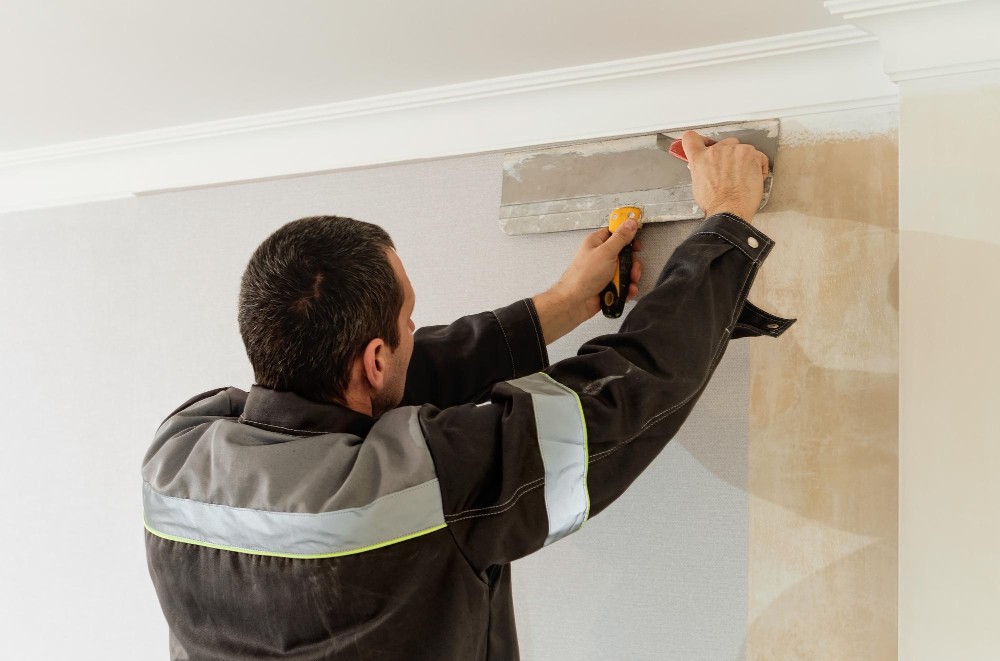
With regards to interior wall finishes and surface restoration, two common terms usually arise—plastering and skimming. Even though these terms are used interchangeably, they are not the same procedures. Both include implementing a plaster mixture to walls or ceilings. However, their purposes, techniques, and end results differ in numerous ways. For homeowners, builders, and renovators, understanding the difference between these two techniques is essential for making an informed decision for your project.
In this comprehensive blog, we will walk you through the major distinctions between skimming and plastering, exploring their applications, techniques, advantages, and when each method must be utilised.
In simple terms:
Plastering is about implementing a thick layer of plaster to surfaces, usually used on bare walls or damaged areas to reinforce and safeguard the surface.
Skimming includes applying a thin layer of finishing plaster, generally over already plastered walls, to attain a seamless surface ready for decoration.
Although they may appear similar, each serves a distinct role. Let’s break them down further.
Plastering is a fundamental phase in both construction and renovation work. It includes spreading a thicker coat of plaster over walls, ceilings, or other surfaces to offer a robust and level base. This is not only a cosmetic job—it serves a pragmatic purpose in strengthening and safeguarding the structure underneath.
The following are a few of the primary features of plastering:
Purpose: To reinforce surfaces and prepare them for paint or decoration.
Process: Includes mixing and applying a wet plaster mixture to cover walls or ceilings. The thickness of this layer can be adjusted according to the surface conditions.
Result: Once dried, the surface is sturdy, flat, and ready for final finishes, such as painting or wallpapering.
Plastering can be done utilising different materials, depending on the surface and desired finish. These include the following:
Cement Plaster: Created from cement, sand, and water. Frequently used on masonry surfaces, it is perfect for adding durability and resisting moisture in areas such as kitchens and bathrooms.
Gypsum Plaster: A thick coat created from gypsum and water. It is recommended in contemporary construction because of its seamless finish and low tendency to crack or shrink.
Lime Plaster: A conventional mixture of lime and sand is usually made as 1:3. It is breathable and adaptable, making it appropriate for antique buildings.
Every type of plaster has its own unique strengths and is selected based on the project’s particular needs.
Skimming is primarily a finishing technique. It includes applying a very thin layer of plaster—usually referred to as a skim coat—over an existing wall or ceiling to give it a seamless and refined touch. This method is generally selected when the wall is structurally fine but visually imperfect.
Skimming does not add significant structural stability but is extremely efficient in crafting a seamless, polished look.
The skim coat itself is a thin white layer, usually created from lime, that is applied over a rough cement surface. Depending on the plasterer’s experience and tools, various techniques can be utilised to accomplish a smooth finish.
The following are a few of the major points to keep in mind regarding skim coats:

Despite the fact that both techniques involve plaster, their applications and results vary considerably. Here is a comprehensive analysis of how they differ from each other:
Plastering: Appropriate for new builds or areas where the wall is damaged or uneven. It crafts a brand-new surface.
Skimming: Perfect for refreshing pre-existing plastered surfaces that only require smoothing out.
Plastering: Needs a thicker application, usually between 10mm to 20mm.
Skimming: A thin coat, generally between 2mm to 5mm, is sufficient.
Plastering: Commonly applied over raw surfaces, such as bricks or concrete blocks.
Skimming: Applied over previously plastered or painted surfaces that require touch-ups.
Plastering: Cement plaster, gypsum plaster, or lime plaster can be used depending on the type of surface and required finish.
Skimming: Utilises a finishing plaster appropriate for seamless top-coating.
Plastering: Takes numerous days to cure and dry totally.
Skimming: Generally dries within 24 hours, depending on room temperature and humidity.
Plastering: Involves more material and time, resulting in increased costs.
Skimming: Needs less material and labour, making it swifter and more economical.
Plastering: Cement-based plaster is well-suited for use in damp conditions.
Skimming: Not suggested for areas with elevated moisture levels.
Plastering: Adds strength and longevity to walls, making it a superior option for structural work.
Skimming: Improves appearance but does not contribute to the wall’s strength.
You must consider plastering when:
Plastering is your preferred solution when you are coping with surfaces that require not just aesthetic enhancement but also structural improvement.
Skimming is more appropriate for:
It is the perfect option when the base is solid and only the surface appearance requires an upgrade.
Comprehending the difference between skimming and plastering is necessary prior to commencing any wall or ceiling work. Both techniques serve their own purposes and are crucial in various scenarios. While plastering is essential for crafting or repairing a wall from the ground up, skimming is excellent for enhancing already plastered surfaces and giving them a perfect finish.
Selecting the appropriate method depends on the condition of your walls and the results you are striving for. For those who want to ensure quality work, seamless finishes, and long-term results, working with seasoned experts is highly recommended.
To ensure premium craftsmanship and knowledgeable guidance personalised to your project, consider hiring Judge Plastering Contractors, where accuracy and quality are guaranteed every time.
Copyright © 2025 Judge Plastering. All Rights Reserved.